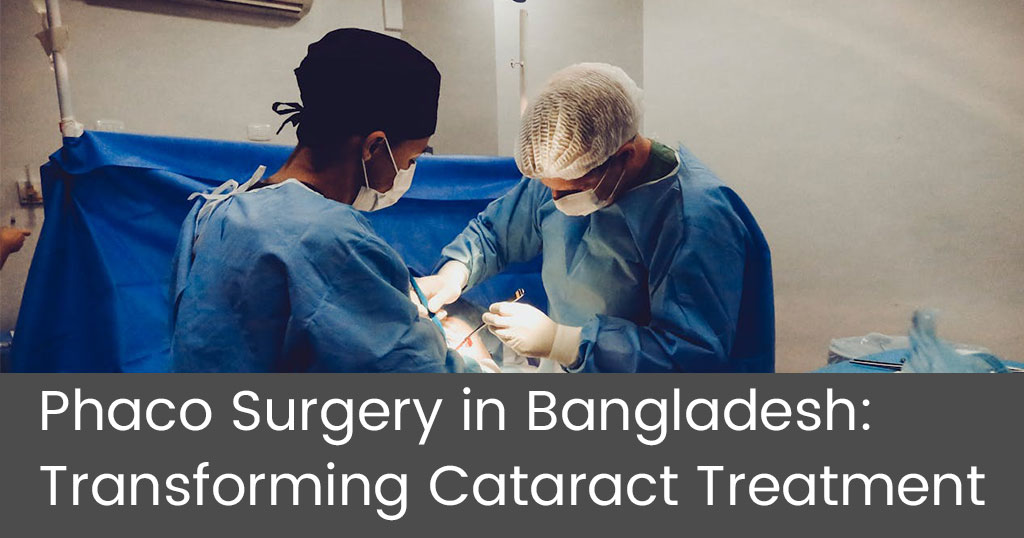Phaco Surgery in Bangladesh: Transforming Cataract Treatment
Table of Contents
Toggle
Phaco Surgery in Bangladesh
Phaco surgery, or phacoemulsification, is a common and increasingly popular method for cataract removal in Bangladesh. The country has made significant advancements in ophthalmic care, and many hospitals and clinics now offer this advanced cataract surgery. Here are some key points about phaco surgery in Bangladesh.

Phaco Surgery Cost in Dhaka
Cost: The cost of phaco surgery in Bangladesh can vary widely depending on the hospital, the type of intraocular lens (IOL) used, and the surgeon’s experience. On average, the cost ranges from BDT 15,000 to BDT 60,000. Some high-end clinics may charge more.
Major Hospitals and Clinics:
National Institute of Ophthalmology & Hospital (NIOH): Located in Dhaka, NIOH is a leading institution for eye care, offering advanced cataract surgeries including phacoemulsification.
Ispahani Islamia Eye Institute and Hospital: Dhaka is renowned for its comprehensive eye care services.
Chittagong Eye Infirmary and Training Complex (CEITC): Located in Chittagong, this institution provides quality eye care and surgery.
Sheikh Fazilatunnessa Mujib Memorial KPJ Specialized Hospital and Nursing College: Situated in Gazipur, this hospital offers various specialized eye surgeries, including phaco.
Accessibility: Phaco surgery is widely available in urban areas and major cities like Dhaka, Chittagong, and Sylhet. Rural areas may need more access. But mobile eye camps and outreach programs often help bridge this gap.
Step-by-step Phaco Surgery Procedure:
Anesthetic: The patient is given a local anesthetic to numb the eye and reduce any pain. Or discomfort during the procedure. Sedatives may also be administered to help the patient relax.
Incision: A tiny incision is made in the cornea, the clear front part of the eye.
Capsulotomy: A circular opening is made in the lens capsule, which is a thin membrane that surrounds the lens.
Phacoemulsification: A small probe is inserted through the incision and into the lens. The probe emits high-frequency ultrasound waves that break up the cloudy lens into small pieces, which are then suctioned out of the eye.
IOL Implant: Once the cloudy lens has been removed, an artificial lens, known as an intraocular lens (IOL), is inserted into the same lens capsule that holds the natural lens.
Closure: The technique performed means that the incision created is self-sealing.

Phacoemulsification recovery tips
Recovering from phacoemulsification (phaco) cataract surgery involves. This follows specific guidelines to ensure a smooth healing process and optimal results. Here are some essential recovery tips:
1. Follow Postoperative Instructions
- Eye Drops: Use prescribed eye drops as directed by your surgeon. Typically, this includes antibiotics to prevent infection and corticosteroids to reduce inflammation.
- Administration: Follow instructions on how to apply the drops. Including the frequency and duration of use.
2. Protect Your Eye
- Eye Shield: Wear an eye shield, especially while sleeping, to protect the eye from accidental rubbing or injury.
- Sunglasses: Use sunglasses or a wide-brimmed hat to shield your eyes from bright lights and UV rays.
3. Avoid Rubbing or Pressing
- No Rubbing: Avoid touching, rubbing, or pressing on the eye to prevent irritation.
- Careful Handling: Be gentle when washing your face or applying makeup.
4. Limit Physical Activities
- Avoid Strain: Refrain from strenuous activities. Heavy lifting, and bending over for the first few weeks to prevent increased intraocular pressure.
- Gentle Exercise: Light activities like walking are generally permissible. Avoid exercises that could strain the eye.
5. Keep the Eye Clean
- Avoid Water Exposure: Keep water out of your eyes while showering or washing your face. Use a clean, dry washcloth to gently pat the eye area if needed.
- Hygiene: Maintain good hand hygiene to avoid transferring bacteria to the eye.
6. Follow-Up Appointments
- Regular Check-Ups: Attend all scheduled follow-up appointments with your ophthalmologist for any concerns.
- Report Issues: Contact your surgeon if you experience significant pain, sudden vision changes, or any unusual symptoms.
7. Manage Vision Changes
- Temporary Blurriness: It’s normal to experience some blurriness or light sensitivity initially. This usually improves as healing progresses.
- Vision Correction: You may need glasses for reading or other close-up tasks even after cataract surgery. Depending on your preoperative vision and the type of IOL used.
8. Adhere to Activity Restrictions
- Avoid Swimming: Refrain from swimming or using hot tubs for at least two weeks or as advised by your surgeon to prevent infection.
- Dust and Allergens: Stay away from environments with excessive dust or allergens that could irritate the eye.
9. Diet and Health
- Healthy Diet: Eat a balanced diet rich in vitamins and antioxidants to support overall eye health and recovery.
- Hydration: Drink plenty of water to stay hydrated, which supports the healing process.
10. Monitor for Complications
- Watch for Symptoms: Be aware of symptoms such as severe pain, redness, swelling. Decrease in vision, which may indicate complications.
- Seek Help: Contact your eye doctor if you have any concerns or symptoms that are out of the ordinary.
By following these tips, you can help ensure a smooth recovery from phacoemulsification surgery. Achieve the best possible outcome for your vision.
Conclusion:
Phaco surgery in Bangladesh has become more accessible and affordable over the years, providing many people with the opportunity to regain clear vision. If you’re considering phaco surgery in Bangladesh, it’s essential to consult with a reputable ophthalmologist to discuss your specific needs and options.